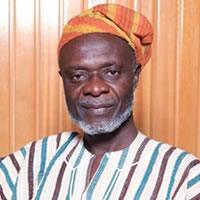Introduction
The bedrock of every developing society is to have a continuous system of constant training and instruction for the development of the mind and character of its inhabitants. In general, education contributes to the process of moulding attitudinal skills and developing technical skills and also increases the ability to understand and respond to new ideas.
Education can be formal or non-formal but both play equal roles in the upbringing of an individual, which to a large extent leads to the development of the nation as a whole. It is a key policy of every government to provide adequate resources and an environment that is safe for learning and training its future human resources.
This chapter analyses data from the 2010 Population and Housing Census on key characteristics of education and literacy. These include literacy levels by district, age, sex and locality of residence; age-sex specific literacy rate among heads of households; school attendance (past and current) of the population six years and older by sex, district and locality of residence; and educational attainment of the population 15 years and older.
Literacy
The 2010 census classifies a literate person as someone who can read and write a simple statement with understanding. If a person can only read but cannot write or can write but cannot read, he or she cannot be considered as literate.
Table 7.1 shows literacy levels for persons 11 years and older by district. It is observed that in the region as a whole, 62.5 percent of the population are not literate in any language. About 19.2 percent are literate in English and a Ghanaian language, 16.3 percent in English only and 1.5 percent in a Ghanaian language only. Less than 1 percent can speak and write English and French (0.1%) and English, French and a Ghanaian language (0.1%).
About 40.0 percent of the population in Tamale Metropolis is not literate in any language, while the proportion is more than 50 percent in the rest of the districts. Bunkpurugu-Yunyoo has the highest proportion (31.5%) of persons who are literate in English language only, while Gushiegu (4.1%) have the lowest proportion. About one third of the population in Tamale Metropolis (34.4%) is literate in English and a Ghanaian language, the highest proportion among all the districts.
Literacy levels by district and locality of residence is presented in Table 7.2. As expected, there are differences among the proportions of literate and non-literate people across all districts. The proportion of non-literate people is higher in rural areas than in urban areas. The highest proportion of urban literate persons is found in Tamale Metropolis (48.4%) and the lowest proportion is in Tolon Kumbungu (4.3%).
Table 7.2 also shows that overall, a higher proportion of rural people (18.9%) aged 11 and older is literate than the proportion of people of the same age spread in urban areas (18.3%). The difference is most pronounced in Kpandai District where 29.7 percent of rural people are literate compared with 6.7 percent of urban people, and in Tolon Kumbungu District (21.9% against 4.3%).
Age-Specific Literacy Rates among Literate Heads of Household
Table 7.3 shows age-specific literacy rates among literate heads of household. The region recorded an overall literacy rate of 4.9 percent, substantially lower than the national figure of 21.9 percent. Literacy rates in general increase by age group from 0.5 percent for the 11-19 year group to 10.7 percent for 50-59 year group and decline to 3.4 percent for 70-99 year group. With respect to differences by sex, age-specific literacy rates are higher for male heads of household (31.7%) than for female heads of the same category (12.9%).
School Attendance (Past and Present)
Table 7.4 shows the population aged six years and older who have ever attended school. In all the districts except three, Bole (47.9%), Tamale Metropolis (27.7%) and Bunkpurugu-Yunyoo (38.4%), more than 50 percent of the male population has never been to school. The proportion of females that has never been to school remains higher than that of males.
The highest level of education attained in all the districts by the greatest proportion of both sexes is primary school. The proportions range from 19.1 percent in Gushiegu to 33.5 percent in Bunkpurugu-Yunyoo for males and from 15.2 percent in Gushiegu to 28.1 percent in Bunkpurugu-Yunyoo.
The proportion of males reaching Middle School/JHS/JSS level, which is the second highest educational level attained by a significant proportion of people in the districts, ranges from 5.5 percent in Gushiegu to 18.9 percent in Tamale Metropolis. The female proportions vary from 3.1 percent in Gushiegu to 14.9 percent in Tamale Metropolis. The disparity between males and females increases with higher levels of educational attainment.
Date Created : 11/28/2017 7:06:56 AM





 facebook
facebook twitter
twitter Youtube
Youtube TOLL FREE 0800 430 430
TOLL FREE 0800 430 430 +233 593 831 280
+233 593 831 280 GPS: GE-231-4383
GPS: GE-231-4383 info@ghanadistricts.com
info@ghanadistricts.com Box GP1044, Accra, Ghana
Box GP1044, Accra, Ghana